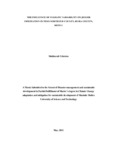| dc.description.abstract | For decades, climate variability has had great effect on human life; both positively and neg122`atively. These effects include rise in the global temperatures, changes in the precipitation patterns, increase in drought incidents and heat waves, stronger and more intense hurricanes, rise in sea level (1-4 feet by 2100), arctic regions likely to become ice free and negative impact on human health. Changes in climate have impacted negatively on human health where by it has led to increase in parasitic infestations like jiggers due to the general increase in global temperatures; which provide favourable environment for breeding. Such increase in parasites, in this case the jigger, has consequently affected the community at large; ranging from the full range of people. It has led to absenteeism from school among the school going children, repeat of classes as well as school dropouts, reduction in economic productivity, stigmatization, poverty, deformities, secondary diseases such as tetanus and death. This research aimed at establishing the influence of climate variability on jigger infestation, determining climate trend and variability of Teso North sub-county, assessing the relationship between jigger infestation and climate change, assessing the current impacts of jigger infestation and evaluating the measures of preventing and controlling jigger menace in Teso North sub-county. The study was carried out in Teso North sub-county because it has a humid tropical climate with warm temperatures and it is among the affected regions with jigger infestation in Kenya. The study focussed on climate parameters (independent variables- climate variability, temperature, rainfall and humidity) against jigger infestation (dependent variable) which was affected by some factors such as poverty, hygiene, level of education, public sanitation measures and gender (intervening variables). Methodologies adopted were descriptive, historical and correlation designs. Data was collected through questionnaires, interviews, observation, field check lists as well as photography. Data was presented in various ways such as photographs, frequencies, percentages, bars and maps. The study found out that climate variability has an influence on jigger infestation. The effect of climate on jigger infestation according to elders was seen to be more prevalent in dry seasons with 95.3% while some believed that jiggers are rampant and increases at wet seasons 3.1%. The change in climate over years was seen to affect the entire sub-county across all wards as informed by key respondents at Alupe Meteorological station indicating a complexity in weather prediction, they indicated that the weather patterns had become more varied with 88.8% (82 cases) of adults indicating a change in climate and community leaders indicating the same too. The change in the temperatures saw 88% of adults report that they had witnessed a change in temperature citing hot temperatures throughout the season while the meteorological department also agreed with the change in temperature. Recommendations such as provision of closed shoes by foundations, well-wishers and other concerned authorities and intensification of awareness programmes from the findings were made open and readily available for any concerned authority. | en_US |

